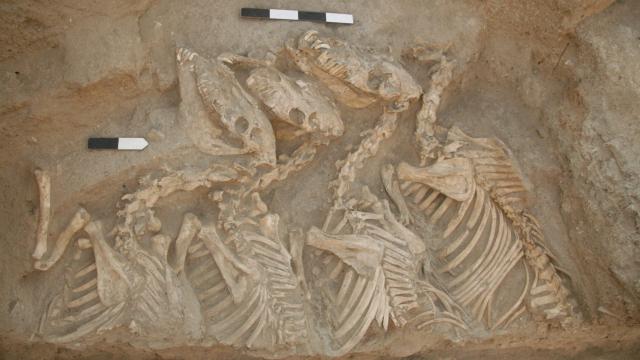A team of geneticists, archaeologists, and paleontologists believe they’ve settled the identity of an enigmatic equid from ancient Mesopotamia. That animal is a kunga, which the researchers show was a cross between a female donkey and a male Syrian wild arse.
Kungas were valuable in Mesopotamia, costing up to six times as much as a donkey. The large equids were used in royal dowries, to pull vehicles of the elite and tow chariots in war, while smaller kungas were used in agriculture. But their identity has long been in dispute; some researchers thought that kungas were merely onagers, a type of wild arse.
To figure out the animal’s true identity, the researchers turned to ancient skeletons of an unknown equid buried in Syria, the last surviving genetic material of an arse species, and the evolutionary history of the genus Equus. The collaboration’s findings were published today in Science Advances.
“The combination of the ancient genomes, the burial treatment, and the archaeological records suggest these hybrid animals correspond to the valuable kungas,” said study co-author Eva-Maria Geigl, an expert in paleogenomics at the University of Paris, in an email. “The analysis of these ancient genomes both solved a long-standing controversy and identified the earliest human-made equid hybrids, highlighting their critical role in the ‘art of war’ centuries before the first domestic horses arrived in the area.”
Hybrid animals are the result of breeding between different species. The animals are mostly always sterile (such as mules, the donkey-horse hybrid, or the liger, the lion-tiger hybrid), which means they must be intentionally bred into existence in each individual case. The size and speed of kungas made them more useful than asses for towing vehicles.

The team analysed 25 equid skeletons found at a 4,500-year-old elite burial ground about 55 km east of Aleppo, Syria. Some of the animals appeared to be deliberately killed for burial. Analysis of the equids indicated the creatures were not horses, asses, or onagers. That led researchers to believe they may be a hybrid animal. The skeletons’ teeth were worn, suggesting that in life they wore bits.
To certify the identity of the skeletons, the team compared genetic samples from the bones to an equid sample from the famous archaeological site Göbekli Tepe in Turkey and to the last surviving Syrian wild asses (now dead), which are conserved at the Natural History Museum of Vienna, in Austria.
Using polymerase chain reaction and shotgun sequencing to amplify the DNA, the researchers found that the Turkish sample was the same species as the animals conserved in Austria, and represented the paternal lineage of the skeletons in Syria. The donkey (E. africanus) was the maternal lineage of the mystery equid, and, based on the Y-chromosome fragments from the samples, the Syrian wild arse, or hemippe (E. hemionus) was the paternal lineage. Later Syrian wild asses were smaller than kungas, so the team posits that surviving wild asses were a smaller descendant of earlier members of the species.
“It is surprising to see that these ancient societies envisioned something so complex as hybrid breeding, since this was an intentional act: they had the domestic donkey, they knew they cannot domesticate the Syrian wild arse, and they did not domesticate horses,” Geigl said. “So, they intentionally developed a strategy to breed two different species to combine different characters that they found desirable in each of the parent species.”
It’s unknown what coat colour the kungas may have had; until now, researchers have gone off Sumerian depictions of the animals, like in the Standard of Ur, Geigl said. Genetics might be the only hope for answering that question, as it certainly won’t be answered through breeding: the Syrian wild arse went extinct in 1929. With its extinction, so too did the kunga die out. But more genetic research and other archaeological discoveries could at least help us better picture this not-so-distant history.
More: Medieval Warhorses Were Actually Quite Small, Study Finds
